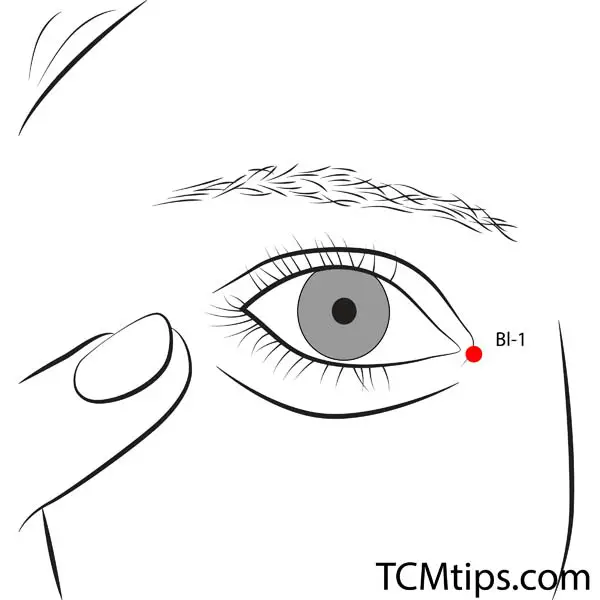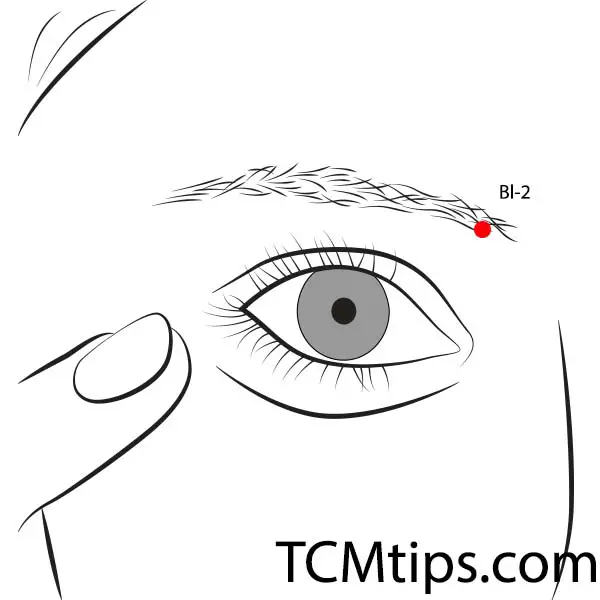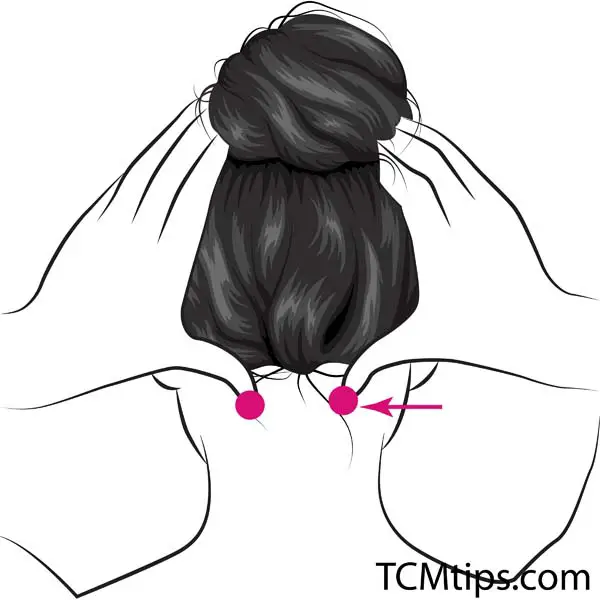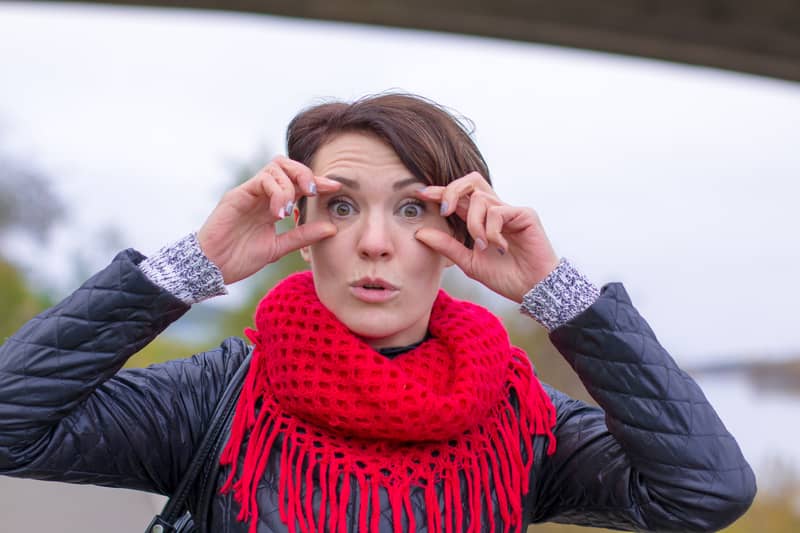Watery eyes can have many causes, from allergies to eye infections. In some cases, it may be due to a reaction to a foreign object in the eye, such as dust or pollen. It could also be a sign of more serious underlying conditions such as glaucoma or diabetes.
If you experience watery eyes on a regular basis, it is best to see an ophthalmologist to rule out any serious health concerns. In the meantime, there are a few things you can do to relieve the symptoms, like use acupressure points for watery eyes.
Acupressure massages have long been known as an effective treatment in Traditional Chinese Medicine and can help with sinus congestion, facial pain, and double vision.
To enjoy the benefits of acupressure for watery eyes, you first must know the acupuncture points for eye-related problems.
Is Acupressure Good For Eyes?

Watery eyes might manifest due to an allergic or inflammatory response. Being one of the acupressure points for watery eyes, acupoint GB-20 can be highly effective in managing watery eyes caused by nasal congestion and runny nose.
In 2018, a study with a sham acupuncture control group was designed to examine the true Chinese Medicine acupuncture therapy’s impact on patients with dry eye conditions.
Acupuncture was found to be a good adjunct treatment for efficiently reducing dry eye symptoms, especially given the minimal risk profile. This concludes that GB-20 is one of the viable acupuncture points for watery eyes.
Acupressure is used as an alternative treatment to relieve stiffness and tension around the eyes, improving blood flow to the lacrimal glands and promoting tear secretion. In addition, the effects of acupuncture can be used to regulate the autonomic nerves by stimulating various acupoints of the body, such as the neck, shoulders, and back.
Acupoint: Bl-1 (Other Names: Urinary Bladder-1/Jing Ming/Bright Eyes)

The acupressure point “BL-1”, is represented in Traditional Chinese Medicine as “Jingming” and in English as “Bright Eyes.” It can be located 0.1 cun superior and 0.1 cun medial to the medial canthus of the eye, between the two veins (if visible), or at the center of the crease if it runs this far to the center.

Acupoint BL-1 is classified as a Crossing point of the Urinary Bladder, Small Intestine, Stomach Meridians, and the Yin Qiao and Yang Qiao Vessels. This acupoint benefits the eyes, dispels wind, and clears heat.
BL-1 is traditionally used to enhance the benefits of other points such as the feng chi point GB-20 to treat physical eye disorders such as weary eyes, redness, soreness, itching, and excessive or inadequate lacrimation of the tear ducts. It is one of the acupressure points for watery eyes that aids in the treatment of impaired vision, visual disorientation, color blindness, photophobia, and nearsightedness. And BL-1 is an appropriate point of acupressure for watery eyes when eye issues are caused by an external pathogenic invasion, such as cold, wind, or heat.
In 2018, a clinical trial was conducted to investigate the efficacy and safety of acupuncture at BL-1 acupoint in treating moderate to severe dry eye disease. Acupuncture intervention at BL-1 can increase the function of the lacrimal sac to secrete tears, explaining the long-term benefit of acupuncture treatment.
Based on prior clinical research, it was concluded that using this acupressure point for dry eyes, the treatment of dry eye conditions may be more successful and convenient.
Acupoint: Bl-2 (Other Names: Urinary Bladder-2/Zan Zhu/Gathered Bamboo)

The acupressure point “BL-2”, is represented in mandarin as “Cuanzhu” and in English as “Bamboo Gathering.” It can be located on the face, on the supraorbital notch, and in the depression on the medial end of the brow.
Wind is expelled, the eyes are brightened, the liver is soothed, obstructions in the channel are removed, and pain is relieved through this acupoint. One of the acupressure points for watery eyes, the BL-2 is helpful with conditions such as pain and discomfort in the supraorbital region, blurred vision, redness, puffiness, pain in the eye, hiccups, and diaphragmatic spasms.
Massage this point for 3 minutes to treat glaucoma, blurred vision, dry eyes, night blindness, headaches, and myopia. Most people can enhance and even preserve their eyesight by using this acupressure self-massage technique until they are far into their elderly years.
It also aids in the treatment of allergic or inflammatory eye disorders, which might result in watery eyes. Acupuncture has exhibited potential for treating dry and watery eyes, a challenging ailment to manage. Acupuncture is a viable choice for patients who have not found a solution to their dry and watery eye problems through traditional means.
A research conducted in 2009 focused on the most recent innovative technologies that support the advancement and development of acupuncture and other innovative simulation approaches.
The stimulation of acupuncture point BL-2, which is said to facilitate glaucoma acupuncture in traditional Chinese medicine, resulted in increased blood flow velocity in the ophthalmic artery. BL-2 is also used as one of the acupressure autoimmune inflammation points.
Acupoint: GB-20 (Other Names: Gallbladder-20/Feng Chi/Wind Pool)

The acupoint GB-20 is known as a “feng chi point” which means “Wind Pool”. GB-20 is situated on the nape, below the occiput, in the depression between the top section of the sternocleidomastoideus and the trapezius muscles.
It is classified as the Crossing point of the Gall Bladder Meridian and the Yang Wei Vessel. This acupressure point dispels exterior and interior wind, clears the mind, helps the eyes, nose, and ears, restrains Liver Yang, stimulates the meridian, and reduces pain. GB-20 can be used for treating:
– a common cold
– nasal congestion
– headache
– redness
– puffiness
– sinus pain
– pain in the eye muscles
– runny nose and flu symptoms
– stiffness and discomfort in the neck
– shoulder restriction
– drowsiness
– vertigo
– hemiplegia
– epilepsy
Massage the bilateral GB-20 points with a gentle circular motion and light to moderate pressure. Apply light pressure to this point, hold for 30 seconds, then release and continue to massage firmly for one to three minutes. Repeat as needed during the day.
Watery eyes might manifest due to an allergic or inflammatory response. Being one of the acupressure points for watery eyes, acupoint GB-20 can be highly effective in managing watery eyes caused by nasal congestion and runny nose.
The aim of a study conducted in 2020 was to determine the feasibility of a study design for comparing the effectiveness of acupuncture treatment with usual care and with usual care alone for dry eye syndrome following refractive surgery.
This Chinese Medicine study used a total of seventeen acupressure points for the eyes, including GB-20. The findings of this study indicate that patients can benefit from acupuncture in addition to standard care for the management of dry eye syndrome after refractive surgery. It is also one of the points relating to acupressure for sinus inflammation.

Try our Anti-Aging Gua Sha Tool designed to bring out your skin’s natural glow.
Best Gua Sha Product- Anti-Aging: The tool is designed to target 11 specific aging signs such as wrinkles and sagging skin. By following the 7-step routine, users can improve skin firmness and reduce fine lines naturally.
- Enhances Skincare Routine: It works effectively with serums and lotions, boosting absorption and efficacy of skincare products.
- Visible Skin Improvement: Users can expect a smoother complexion, reduced puffiness, and a more youthful appearance.
 P. Sze
P. Sze 

















